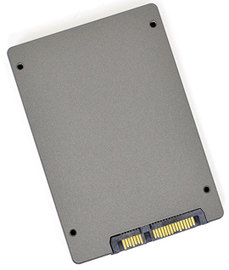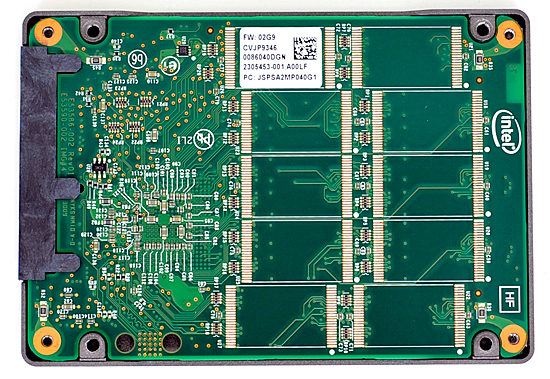The SSD Improv: Intel & Indilinx get TRIM, Kingston Brings Intel Down to $115
by Anand Lal Shimpi on November 17, 2009 7:00 PM EST- Posted in
- Storage
Kingston Delivers the First Good Sub-$100 SSD (after Rebate)
I’m not sure what sort of sweetheart deal Intel inked with Kingston, but it’s paying off. Other than Hitachi, Kingston is the only company allowed to use Intel’s controllers in their SSDs. And today, it gets even more interesting. The Kingston SSDNow V Series 40GB Boot Drive is a 34nm X25-M G2 with only 40GB of MLC NAND Flash on it.


You read that right, Kingston gets to make a 40GB X25-M G2 under its own brand.
Kingston wants this to be specifically used for your OS and applications, where the speedy launch performance of an SSD is most useful. You’d keep your games, data and other large files on a separate hard drive. Why 40GB? To keep costs down of course. The Kingston drive goes on sale starting November 9th. The MSRP of the drive will be $115 ($130 with a 2.5” to 3.5” drive adapter), Kingston is offering a rebate through Newegg that will apparently drop the price to $84.99.
Kingston’s goal was to hit the sub-$100 price point and they did it, sort of. I’m not a big fan of mail-in rebates, and it remains to be seen if Newegg can keep the drive in stock at those prices, but the intention is good.

Only 5 devices means the Intel controller works in 5-channel mode, instead of 10-channel like the X25-M G2
While the drive uses an Intel 34nm X25-M controller and 34nm flash, it doesn’t have the latest firmware from Intel, which means it doesn’t support TRIM. Since it’s technically not an Intel drive you can’t update it using the firmware I linked to earlier. The drive will most likely eventually get TRIM support, just not now. Unfortunately it doesn't even work with Intel's SSD Toolbox, again, because it's technically a Kingston drive.

With only half the NAND flash of an 80GB X25-M (only five NAND devices on board), its sequential write speeds are cut in half - Kingston rates the drive at 40MB/s. Random performance suffers a bit, but sequential write performance sees the biggest hit.
If you've already got a large hard drive for games/data and don't have that many apps installed, the Kingston 40GB SSD is a perfect way to move to an SSD affordably.










162 Comments
View All Comments
Anand Lal Shimpi - Monday, October 26, 2009 - link
Personally my pick is still the X25-M, it's had a better track record than any of the other controller makers. The problem for Intel is that Indilinx performance and feature set have both gotten a lot better.You now get TRIM, reliable performance, competitive pricing and generally everything but a super dynamic controller that's constantly trying to maximize performance. Depending on the usage scenario though, the latter may not matter as much (see my Photoshop results from the last review or the heavy trace results from this review).
My position hasn't really changed, just highlighting the importance of the issue so that hopefully Intel's value SSDs next year aren't just rebadged G2s :)
Take care,
Anand
7Enigma - Monday, October 26, 2009 - link
I think his previous review is consistent with this one. His ultimate recommendation between Intel and Indlinx drives has remained unchanged. That is, they are close enough that the size differences should be the decider for a potential buyer.As it stands, in most normal usage scenarios the statement from his last article still applies. There are very few times where you are going to be constantly tapping the 80MB/s barrier. More often you will be limited by the other SSD's lower random write speeds.
What his own benchmark can show is that in uncommon circumstances you can sway the bar back towards parity between the brands. I would argue, however, that the "heavy" usage scenario is not a practical one for an SSD. Just read his description again and look for all of the places the average user would NOT be putting that data onto an SSD:
[quote]
In this test we have Microsoft Security Essentials running in the background with real time virus scanning enabled. We also perform a quick scan in the middle of the test. Firefox, Outlook, Excel, Word and Powerpoint are all used the same as they were in the light test. We add Photoshop CS4 to the mix, opening a bunch of 12MP images, editing them, then saving them as highly compressed JPGs for web publishing. Windows 7’s picture viewer is used to view a bunch of pictures on the hard drive. We use 7-zip to create and extract .7z archives. Downloading is also prominently featured in our heavy test; we download large files from the Internet during portions of the benchmark, as well as use uTorrent to grab a couple of torrents. Some of the applications in use are installed during the benchmark, Windows updates are also installed. Towards the end of the test we launch World of Warcraft, play for a few minutes, then delete the folder. This test also takes into account all of the disk accesses that happen while the OS is booting.
The benchmark is 22 minutes long and it consists of 128,895 read operations and 72,411 write operations.
[quote]
How many people are going to be opening photoshop pictures FROM the SSD and saving them TO the SSD? Same goes with Windows Picture Viewer. Most people will have their pics on a standard large mechanical HD which makes this a moot point. Downloading large files from the net? Not a chance that would be going to my SSD! Bottom line is this is a great HELL test, but nowhere close to real-world usage.
The light-usage probably fits 90% of people 90% of the time (completely made up statistic).
With all of that said, I wish Intel's 80gig drive had closer sequencial write performance as the Indilinx drives, as it would make the decision a complete no-brainer. Looking at all the data, and planning on buying a ~$250 drive this holiday season has me very likely picking up an 80gig Intel as for me the price is about as steep as I'm willing to go for essentially a boot drive, with performance that for the majority of the time is at the top of the pack. It would be WAYYYY more difficult to decide if both Intel/Indilinx had the same drive sizes but fortunately we don't have to worry about that (at least for now....)
tynopik - Monday, October 26, 2009 - link
on page 7, all the graphs have two lines labelled 'Intel X25-M G2 80GB (MLC) TRIM'7Enigma - Monday, October 26, 2009 - link
Anand,You have listed the 80gig Intel MLC drive twice in each chart. I'm assuming one of them shouldn't say (TRIM)?
Other than that, GREAT article! Those Kingston drives look to be the PERFECT inexpensive replacement for netbooks/cheaper laptops as the performance is vastly superior to cheap mechanical HD's.
Anand Lal Shimpi - Monday, October 26, 2009 - link
That second 80GB MLC drive was actually a second set of results that didn't get pulled out. I've trimmed em out :)Take care,
Anand
fic2 - Monday, October 26, 2009 - link
"The G1 is more resillient (SIC) than the G2 when it comes to performance degradation over time since it doesn't have TRIM."Is it just me or does this sentence make no sense? I thought the whole purpose of TRIM was to make the SSD more resilient to performance degradation. Seems like it should be:
"The G1 is less resilient..."
klil - Monday, October 26, 2009 - link
The G1 is LESS susceptible to degradation than the G2, Intel compensates this by enabling TRIM on the G2.Anand Lal Shimpi - Monday, October 26, 2009 - link
Correct, my apologies for the confusing wording :)Take care,
Anand
edzieba - Monday, October 26, 2009 - link
"None of the other Indilinx manufacturers have Windows 7 TRIM support yet."Crucial has the TRIM firmware (1819) available for download for their m225 series SSDs.
TheWickerMan - Monday, October 26, 2009 - link
I was just going to post that, but you beat me to it. Here's the link for anyone else interested: http://www.crucial.com/support/firmware.aspx">http://www.crucial.com/support/firmware.aspx